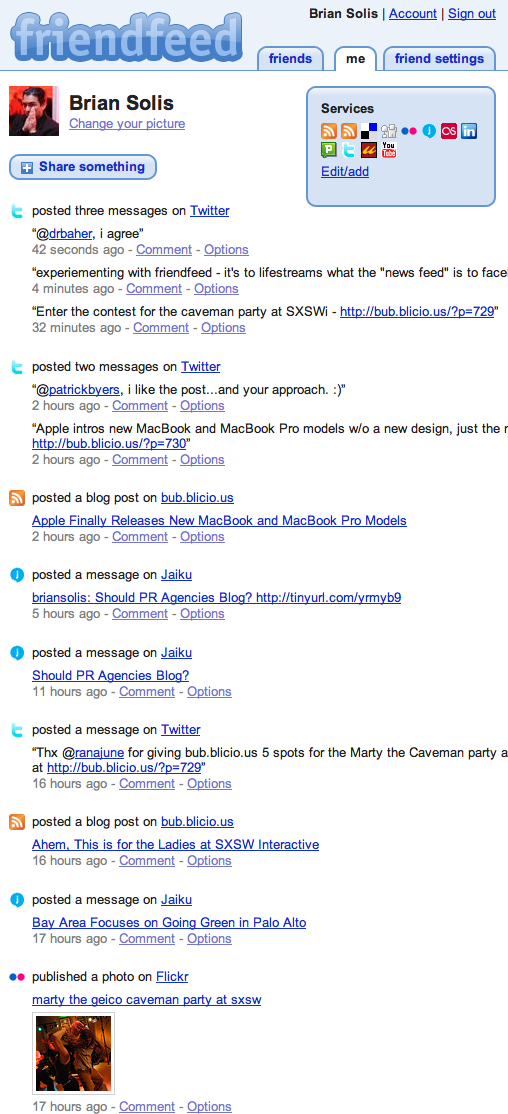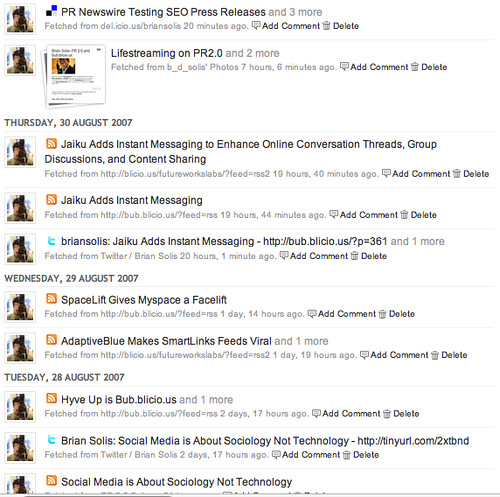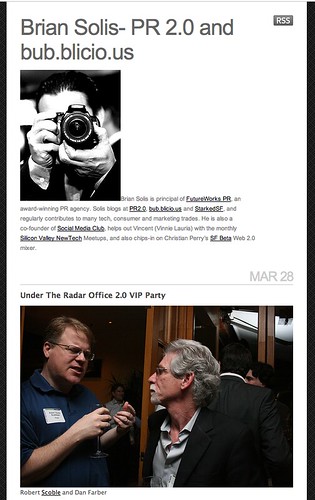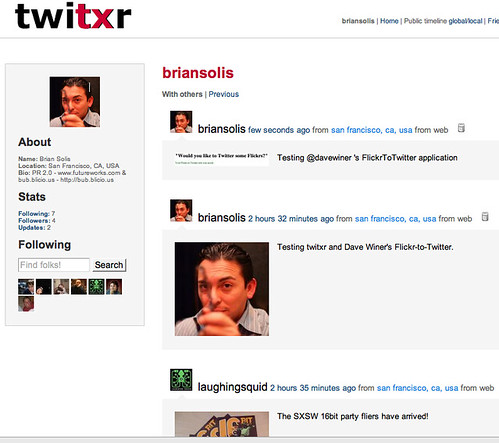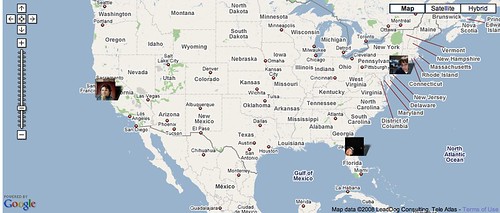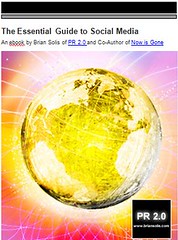
I recently ran "The Definitive Guide to Social Media Releases," which has received some great feedback. Thank you everyone!
Even though it's a blog post, it doesn't mean that its shelf life is merely limited to the brief period of time in between new posts. I'd like it to live on and evolve over time as we learn more about SMRs. And, you're a big part of that evolution.
I was planning on letting that post sit up there for the week, until I received an incredible comment yesterday from Steve Kayser. It's worth spotlighting and sharing as its own post as he has done what many have been asking for, present a real world case study of the effectiveness of Social Media Releases across various wire services.
It's nothing short of insightful, and most importantly, it will serve as a guide when considering how and where to distribute SMRs.As you know, my favorite distribution method is creating, hosting, and channeling a new breed of SMRs through customized blog platform. While it sounds complicated, it really isn't. And it perfectly complements a traditional wire release by providing comprehensive and consistent findability and visibility across traditional search and blog (social media) search engines and also social networks.Please note, if you haven't yet read the previous post, please do so prior to reading this.Without further ado, here is Steve Kayser's report on Social Media Releases in action... ----

Hey Brian:
Nice post. A lot of great points.
As to the question you posed:
And, is this what reporters and bloggers really want and do we really need them?
Are SMRs created for journalists and bloggers and is it what they want?
I was asked this question last week by a marketing manager after having released three test SMR’s. Here’s my answer to the question you posed – and a point.
I care – but not too much.
If you deal in a “complex sale” environment (which we do), a high-dollar product or solution sale (usually over $150,000) requiring buyer evaluation committees, made up of 10-21 people of different functional business groups, it’s more important to make sure our news and content value is “Findable” for those people on the committees when they begin their due diligence. The ‘user”, the “IT person” the “business manager,” “Business decision-maker,” Legal, HR, etc., etc., all have their own unique and specific information needs, which by default includes specific language and terms they use to search for (keywords – key phrases etc.). Sure we want journalists and bloggers to have whatever they need to write their story. We want to be a trusted and valued source. But ... no begging or buying is going to happen for them to write about us. No time for that. The hierarchy has changed. Now for us is - first the buyer’s information needs – then the bloggers, media, analysts, etc.
To stay competitive in the tech industry today you have to be
• Findable
• Believable
• Credible
• Prove Value
... just to get into consideration for the complex sale.
Once you’re findable, believable, credible, then you have to prove value – quickly. The SMR is a great tool to help promote those goals. Most buying committees have their researchers start due diligence on the web. Our internal research shows over 93% of our B2B buyers do it that way.The SMNR helps us be more “findable.”
That’s good. But it also needs to be well-written because a well-written SMR can help us be “believable.” The opposite is also true. Poorly written corporate gobbledygook (to your point in this post) can make you look incredibly unbelievable. Which negates you ever getting into the due diligence buying process. However, good writing is not as easy to do anymore as a lot of folks out there think. (It’s complex to write simple these days.)
“Credible” follows after they do more research. Or not.
MARKETWIRE SMR

I tested Marketwire’s SMNR last week on a Smalltalk Application Development Language press release.
Now ... it’s not great, not brilliant, not a literary piece in any stretch of the imagination, but it’s functional, having included some of the keywords/key phrases for this product group’s audience in the title/subtitle and first 100 words. It’s a highly niche and passionate community.
A U.S. SMR VIEW
Costs:
My view (from the U.S.) is that costs for SMR’s are relatively high. The ability to include the additional informational in the release via the related links section that ads value, ups the word count – which ups the cost because after the first 400 words almost all wire services typically charge you $1.00 a word (or somewhere close).
Multi-media assets:
Being a tech SMB – with a couple hundred million in revenue and producing about 100 press releases or so a year in the US – having video/audio assets available for SMR’s from all the product groups becomes a constant challenge. The marketing and product managers almost have to be evangelists/zealots and do a lot of the video and photos themselves. Some are hip to it. Others resist it like the plague. And, the more video / images / multi-media you do use -- the more the cost goes up.
But having said all that, Marketwire's release delivered exceptional results for us. It got pulled into a lot of our target pubs. It was visually and graphically appealing. The live links in the webosphere section started slowly then gradually grew and continue to do so. I think over 10,000 links now. Google keeps on building, “Live” keeps on building, Yahoo actually started higher (79 links) then declined. It has now shrunk to 1 link. I think that's because their news algorithm churns them into the archive – but I’m not sure about that.
One thing I really liked -- the “comments” section. It was valuable and eye-opening. Comments on a press release valuable? Yes. Several had in-depth insights, past experience comments with the product and questions about the future direction. A lot of the questions were about the topic of the press release – but I had probably 20 emails questioning me about the format of the release itself, which was interesting. But it also caused me more work. I had to write an explanation about the new format for our internal employees, detailing the components and the value of the new format. Then I had to send it to marketing, product and pre/post sales managers that weren't involved in the tests.
Many warmly received it.
Many didn’t.
One great comrade-in-arms, when describing the mindset that did not warmly receive the message and is leery of change, sent me a quote from a Mel Brooks movie – I can’t remember the movie, but do remember the quote.
“It looks dangerous Master … you go first.”
EUROPEAN VIEW

I also used Webitpr.com in the UK last week for a different SMR about a Healthcare Software Application.
First of all, Webitpr.com is a great company to work with. They’re on top of it – especially monitoring the blogosphere. I met them through, of all things, a blog posting on PR-Squared’s blog about the SMR. They saw the posting, responded to me about the content of the post in a courteous, non-obtrusive professional manner and now we're setting up an overseas account with them. Actually released two English press releases and one German press release over the last several weeks. Adam Parker, Jonathan Dolby, Stephen Davies, -- super service. They knock it out quick, -- use the SHIFT template pretty much – have a different distribution reach, but very effective. I think they’re going to be a major player in this field. Hope so anyway. It’s nice to work with people who are passionate, positive and proactive. Cost is competitive, but the U.S. dollar decline might pinch them a bit.
TRACKING ISSUES
Marketwire SMR’s don’t show up on our reporting dashboard like a typical MW release does. This will cause me (and other PR folks who use Marketwire) some issues trying to reconcile cost/value metrics for upper management. The webosphere link tracking is excellent though. Might even have to create a couple new metrics. Something along the lines of “number of comments, actions or emails” on the PR. I’m not sure yet, but we need to be able to prove the value of our PR efforts. I know this is new ground being plowed – but once the seeds are planted eventually some crops better come up.
WEBITPR.com does have tracking that I can easily append to my other tracking efforts - I use VocusPR for tracking and Marketwire as our main distribution service. WEBITPR’s tracking is easy to view, understand, use and pretty cool to boot. The guys over the pond have done a nice job of building their offering. Pretty impressive actually. Hats off to them.
SMR CHALLENGES
One of the major challenges I see though is downstream distribution. The way these SMR’s are rendered and displayed. They are ripped up and displayed in a gazillion different ways. Almost every news site displays the SMR differently. The best you can hope for right now I guess is to get it right where you have control – like for example, Marketwire – or Webitpr – or whatever your distribution vendor happens to be.
However, though seemingly a small issue, “downstream display and rendering” I guarantee you this question will come up when cost-justifying the SMR to internal budget committees - “Why do it if doesn’t get rendered or displayed the correct way. Isn’t that a waste of money?” So, be prepared to cost justify with results.
Few examples:
Yahoo does okay - renders graphics – but no video.
MSNBC – images and video at bottom.
IMPORTANT NOTE

PRXBuilder.com was the best.
And there’s a reason for that.
I developed all my SMR’s on PRXBUILDER first and then uploaded them. Shannon Whitley at PRXBUILDER is superb to work with. Knowledgeable, helpful, courteous, goes the extra step. His PRXBuilder tool can really help people get their minds around the SMR concept easily and quickly. It’s simple, easy-to-use and you can be up and running in a few minutes with it. Plus, it gives me the ability to use the same press release content and deliver it in 4 different formats
• Traditional Release
• Social Media Release
• Multi-media Release
• New Media Release
This is helpful as we gradually ramp up use of the SMR format – I can still do it the old way if need be for some recipients who need it in different formats.It would be great if Marketwire accepted the PRX Format. I know PRNewswire accepts it – but they’re a little pricey right now for this type release.
Thanks for your post Brian.
Great work as always.
Best,
Steve Kayser
------Steve, thank you very much for taking the time to document your experiences. I believe that it will only help guide marketing and PR professionals as they look to navigate the murky and unchartered waters of Social Media. I look forward to your future experiments.
Connect with me on Twitter, Jaiku, Pownce, Plaxo, or Facebooksocial media media2.0 media+2.0 2.0 pr2.0 pr public+relations communications publicity promotion marketing social+media+release socialmediarelease smr smpr hrlease press+release news+release media+release google yahoo technorati blogpulse webitpr prxbuilder msnbc todd+defren shannon+whitley steve+kayser

